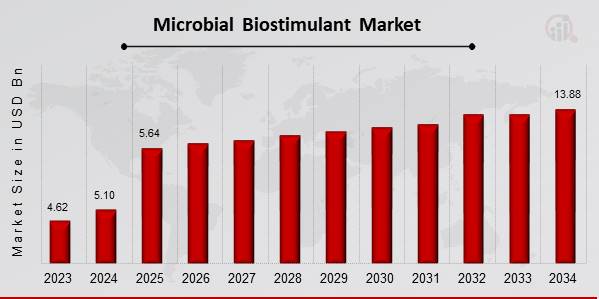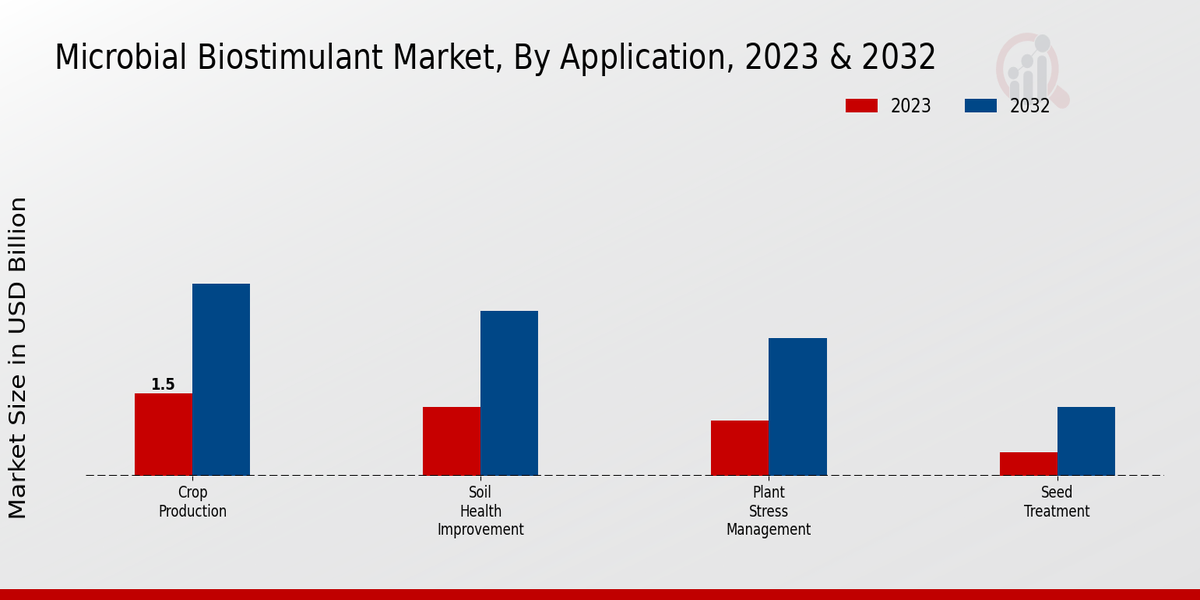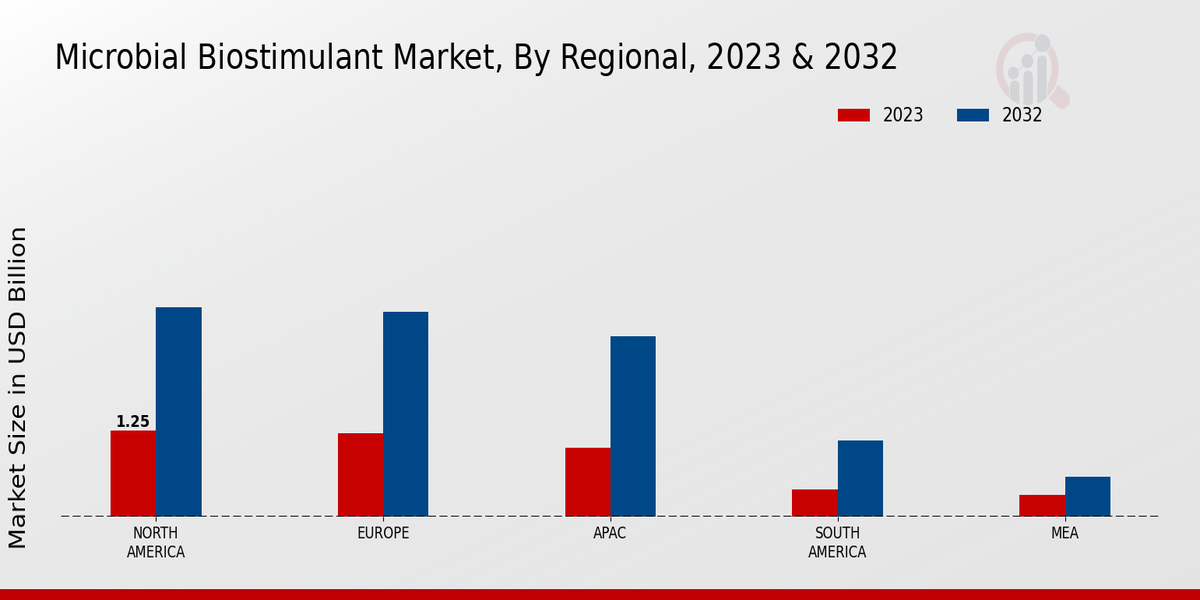Global Microbial Biostimulant Market Overview
Microbial Biostimulant Market Size was estimated at 5.10 (USD Billion) in 2024. The Microbial Biostimulant Market Industry is expected to grow from 5.64 (USD Billion) in 2025 to 13.88 (USD Billion) by 2034. The Microbial Biostimulant Market CAGR (growth rate) is expected to be around 10.5% during the forecast period (2025 - 2034).

Source: Primary Research, Secondary Research, MRFR Database and Analyst Review
Key Microbial Biostimulant Market Trends Highlighted
The Microbial Biostimulant Market is experiencing significant growth driven by various factors. Increased awareness of sustainable agricultural practices is pushing farmers to seek eco-friendly solutions, leading to a higher demand for microbial biostimulants. These products improve soil health, enhance nutrient uptake, and promote plant growth without harmful chemicals. As consumers increasingly prefer organic and sustainably sourced food products, the agricultural sector is responding by adopting biostimulants that align with these trends. Additionally, regulatory support for environmentally friendly agricultural inputs aids in fostering market growth.There are many opportunities to be explored in this evolving market. With advances in biotechnology, the development of new microbial strains presents a chance for companies to explore innovative solutions tailored to specific crop needs. Rising collaborations between research institutions and industry players can enhance knowledge sharing and lead to the introduction of effective biostimulant products. Furthermore, the expansion of the market in developing regions offers extensive growth potential, as farmers seek cost-effective methods to improve crop yields and resilience against pests and diseases. Recent trends highlight a shift towards combining microbial biostimulants with traditional fertilizers to maximize their effectiveness.This dual approach allows for enhanced nutrient efficiency, reducing the overall environmental impact of farming. Moreover, the integration of digital technology in agriculture, such as precision farming, is paving the way for targeted application of microbial biostimulants. The emphasis on product efficacy and the establishment of clear application guidelines reflects the industry’s commitment to meeting farmer needs while promoting sustainable farming practices. As the market continues to evolve, the focus on research and development, along with changing consumer preferences, will play a critical role in shaping its future.
Microbial Biostimulant Market Drivers
Growing Demand for Sustainable Agricultural Practices
The pressure on agricultural output keeps on growing with the world population increase and the hunger for food that comes with it. Farmers and agricultural growers are looking for ways to increase food production without polluting the natural environment. The Microbial Biostimulant Market Industry is on the rise thanks to the growing organic farming and integrated pest management shift. Biostimulants that are beneficial to crops and are derived from natural molecules which help crops to absorb nutrients and cope with abiotic stress will perfectly support the objectives of sustainable agriculture.
With increasing knowledge on the disadvantages of synthetic fertilizers and pesticides, people tend to prefer biological products. Furthermore, chemical use in agricultural activities is increasingly regulated which provides more reason for the use of microbial biostimulants. Soil health and fertility have also been of concern to many, which has led to the use of more and more biological products to increase the soil microbiome.
This trend is further supported by scientific methodology as well, where biostimulants are being studied for their efficiency in different climates and soil types establishing them as necessary components for global food security while maintaining harmony with the environment.
Technological Advancements in Microbial Products
Innovations in biotechnology and microbial formulations are significantly enhancing the effectiveness and applicability of biostimulants. The Microbial Biostimulant Market Industry benefits from advancements in microbial cultures, formulation technologies, and application methods. These innovations not only improve the efficiency of microbial biostimulants but also broaden their spectrum of use across different crops and growing conditions.Advanced research in microbial genomics is leading to the identification of new beneficial strains, providing farmers with targeted solutions for specific agricultural challenges. As these technologies continue to evolve, they are expected to lower production costs and improve user accessibility, thereby stimulating market growth.
Rising Awareness Among Farmers About Biostimulants
There is an increasing awareness among farmers regarding the benefits of using microbial biostimulants. Education and outreach programs by agricultural organizations and institutions are playing a pivotal role in disseminating knowledge about the advantages of these products. The Microbial Biostimulant Market Industry is poised for growth as more farmers recognize the efficacy of biostimulants in enhancing soil health, improving crop yield, and providing resilience against environmental stresses.As farmers become more informed about input alternatives, the demand for microbial solutions is expected to rise, further fueling market expansion.
Microbial Biostimulant Market Segment Insights
Microbial Biostimulant Market Application Insights
The Microbial Biostimulant Market revenue within the Application segment is witnessing robust growth due to rising agricultural demands and sustainable farming practices. In 2023, the market was valued at approximately 4.17 USD Billion, with a significant portion attributable to key areas of application such as Crop Production, Soil Health Improvement, Plant Stress Management, and Seed Treatment. Of these, Crop Production stands out as a major contributor to overall market revenue, valued at 1.5 USD Billion in 2023 and expected to reach 3.5 USD Billion by 2032.The importance of this segment is underscored by the global push for increased food production to support growing populations. Soil Health Improvement also commands a significant share, with values pegged at 1.25 USD Billion for 2023 and projected to hit 3.0 USD Billion by 2032, highlighting the understanding that healthy soil is fundamental to crop yield and sustainability. Additionally, Plant Stress Management plays an important role in the sector, valued at 1.0 USD Billion in 2023, it is projected to grow to 2.5 USD Billion, emphasizing the urgent need for solutions to counteract the adverse effects of climate change on agriculture.Lastly, Seed Treatment, currently smaller at 0.42 USD Billion in 2023 with a forecast of 1.25 USD Billion by 2032, remains a crucial area for enhancing seed performance and plant vigor. The various segments within the Microbial Biostimulant Market segmentation reveal key insights for stakeholders, indicating that as awareness around sustainable agriculture grows, the market growth trajectory will be heavily influenced by the increasing prevalence of microbial solutions across these applications. The trends indicate that innovations in microbial formulations will continue to drive the demand for these biostimulants, presenting opportunities that are ripe for exploration by agribusinesses looking to adapt to changing agricultural practices.Challenges still lie in market penetration and minimizing existing reliance on conventional practices, yet the momentum towards microbial biostimulants remains strong, indicating a pivotal shift in agricultural methodologies. The Microbial Biostimulant Market data suggests that the rising need to optimize crop output and enhance soil health will remain a primary driver for expansion across the Application segment and its specific areas, showcasing significant opportunities for growth and development in the industry as stakeholders seek to align with sustainable agricultural objectives.

Source: Primary Research, Secondary Research, MRFR Database and Analyst Review
Microbial Biostimulant Market Microbial Source Insights
The Microbial Source segment of the Microbial Biostimulant Market is a crucial domain that is witnessing considerable growth amid rising agricultural sustainability concerns. In 2023, the market reached a valuation of 4.17 USD Billion, reflecting a growing acceptance of microbial biostimulants in agricultural practices. This segment can be broadly categorized into various components, with bacteria, fungi, algae, and actinomycetes being significant contributors. Among these, bacteria hold a major share due to their versatile roles in promoting plant growth and enhancing nutrient uptake, which makes them invaluable in modern agriculture.Fungi also play an important role by improving soil structure and plant health through beneficial interactions. Algae are increasingly recognized for their potential to enhance crop resilience against stress conditions, while actinomycetes contribute to soil fertility through their complex interaction with soil nutrients. As part of the Microbial Biostimulant Market revenue growth, the demand for these microbial sources is driven by the rising need for sustainable farming practices, which opens new opportunities and advancement in the industry.However, the market also faces challenges such as the need for precise formulations and regulatory approvals that can sometimes hinder market growth. Overall, the segmentation of the Microbial Biostimulant Market data showcases a dynamic landscape with promising trends and opportunities.
Microbial Biostimulant Market Formulation Insights
The Microbial Biostimulant Market is set to reach a valuation of 4.17 USD Billion in 2023, showcasing a robust growth trajectory influenced by various factors. The formulation segment is integral to this market, emphasizing the delivery methods of these biostimulants. Among the formulations, liquid formulations are particularly popular due to their ease of application and quick uptake by plants, promoting efficient nutrient utilization. Granular formulations also play a crucial role, offering prolonged nutrient release and catering to diverse agricultural practices.Powder formulations are significant as they allow for versatile applications and can be easily mixed with other products, enhancing user convenience. The market growth is supported by increasing adoption of sustainable agricultural practices, demand for organic farming, and a growing preference for biostimulants over chemical fertilizers, all aligned with environmental sustainability goals. Challenges such as regulatory hurdles and market education need to be navigated, yet opportunities exist in developing innovative formulations to meet consumer needs.The Microbial Biostimulant Market data reflects a promising future, highlighted by a projected increase in market revenue to 10.25 USD Billion by 2032, with anticipated growth opportunities driven by changing agricultural trends.
Microbial Biostimulant Market End Use Insights
The Microbial Biostimulant Market, with an overall value of 4.17 USD billion in 2023, showcases a diverse range of applications across various end-use sectors. The major segments include agriculture, horticulture, and turf management, each playing a pivotal role in market dynamics. Agriculture dominates the market due to the increasing demand for eco-friendly farming practices and sustainable crop production, driven by the global shift towards organic farming. Horticulture also holds significant importance, as it enhances the growth and yield of fruits, vegetables, and ornamental plants, thus contributing to diversified agricultural outputs.Turf management has gained traction as well, particularly in maintaining healthy lawns, sports fields, and landscaping, reflecting growing consumer interest in aesthetics and turf quality. Collectively, these segments contribute to the expansion of the Microbial Biostimulant Market, which is experiencing notable growth fueled by innovations and the rising awareness of sustainable agricultural practices. The strong focus on improving soil health and enhancing plant resilience further underscores the opportunities within these end-use sectors, ensuring a promising outlook for the market moving forward.
Microbial Biostimulant Market Regional Insights
The Microbial Biostimulant Market is experiencing robust growth across various regions, showcasing diverse market dynamics and revenue potentials. In 2023, North America is valued at 1.25 USD Billion, demonstrating significant demand driven by advanced agricultural practices and technology adoption, making it a dominant player in the market. Europe closely follows with a valuation of 1.2 USD Billion, where stringent regulations promote sustainable farming practices, further enhancing the importance of microbial solutions. The Asia-Pacific (APAC) region, valued at 1.0 USD Billion in 2023, is witnessing rapid expansion due to increasing awareness of organic farming among smallholder farmers.South America and the Middle East Africa (MEA) represent smaller slices of the market, valued at 0.4 USD Billion and 0.32 USD Billion respectively, reflecting emerging opportunities as these regions strive to improve agricultural productivity. Notably, South America's unique climatic conditions support diverse crop cultivation, while MEA's growing population drives the need for efficient agricultural practices. Collectively, these regional insights illustrate the competitive landscape within the Microbial Biostimulant Market, underscoring key growth drivers and opportunities across varied agricultural practices.

Source: Primary Research, Secondary Research, MRFR Database and Analyst Review
Microbial Biostimulant Market Key Players and Competitive Insights
The Microbial Biostimulant Market is characterized by its dynamic competitiveness as it consists of various players focusing on innovative agricultural solutions to enhance plant growth and productivity. Companies in this market are increasingly investing in research and development to create unique formulations that can address specific crop needs and environmental challenges. The growing emphasis on sustainable agricultural practices fosters a broader acceptance of microbial biostimulants, integrating them into conventional farming. Players are employing various strategies such as partnerships, acquisitions, and collaborations with research institutions to further penetrate the market and expand their product offerings. The escalation of organic farming and stringent regulatory frameworks around chemical fertilizers further give impetus to the microbial biostimulants segment, allowing for substantial growth opportunities.NutriAg stands out in the Microbial Biostimulant Market due to its robust portfolio of products designed to improve nutrient uptake and enhance overall plant resilience. The company is well-regarded for its commitment to quality and innovation, relying on cutting-edge research to develop highly effective microbial solutions tailored to specific agricultural applications. With a strong market presence, NutriAg effectively leverages its extensive distribution network, ensuring that its products are accessible to a wide spectrum of farmers and agricultural professionals globally. The company’s ability to adapt to emerging trends in biology and ecology positions it favorably within the market, and its focus on environmentally friendly solutions resonates well with current consumer preferences towards sustainability in agriculture.BASF is another significant player contributing to the competitive landscape of the Microbial Biostimulant Market. Leveraging its extensive expertise in biotechnology and agronomy, BASF has developed a comprehensive range of microbial biostimulants that effectively address various crop and soil health needs. The company's commitment to sustainability and innovation is further enhanced by its substantial investment in research and development initiatives, aimed at improving agricultural productivity while minimizing environmental impact. BASF's strong global footprint allows it to serve a diverse customer base, facilitating collaborations with farmers and agricultural advisors to optimize the beneficial effects of its products. Its reputation for reliability and effectiveness in enhancing crop yield positions BASF favorably amidst competition, making it a key entity in shaping the future of microbial biostimulants in agriculture.
Key Companies in the Microbial Biostimulant Market Include
- NutriAg
- BASF
- FMC Corporation
- DSM
- Novozymes
- Valagro
- o2h Group
- AgriLife
- House and Garden
- BioWorks
- Kimitec
- Biochemize
- Syngenta
- Stoller USA
Microbial Biostimulant Market Industry Developments
Recent developments in the Microbial Biostimulant Market have shown significant growth driven by increased agricultural demand and sustainability initiatives. Companies like BASF, NutriAg, and Novozymes are expanding their product lines to incorporate innovative microbial solutions that enhance crop yield and resilience. Current affairs indicate a growing trend toward organic farming, prompting firms such as Valagro and Syngenta to invest heavily in microbial technologies. Mergers and acquisitions have been noted, with FMC Corporation acquiring smaller firms to bolster their biostimulant portfolio, while AgriLife and BioWorks have engaged in strategic partnerships to enhance distribution capabilities. The market valuation of these companies is on the rise, reflecting a robust consumer shift towards biostimulants, which is anticipated to bolster sales and overall market dynamics significantly. As government regulations become more favorable toward eco-friendly agricultural practices, companies like DSM and Stoller USA are likely to benefit from maximizing their microbial product offerings. Collectively, these developments point toward an evolving marketplace with substantial investment potential and an increasing focus on sustainable agriculture.
Microbial Biostimulant Market Segmentation Insights
-
Microbial Biostimulant Market Application Outlook
- Crop Production
- Soil Health Improvement
- Plant Stress Management
- Seed Treatment
-
Microbial Biostimulant Market Microbial Source Outlook
- Bacteria
- Fungi
- Algae
- Actinomycetes
-
Microbial Biostimulant Market Formulation Outlook
-
Microbial Biostimulant Market End Use Outlook
- Agriculture
- Horticulture
- Turf Management
-
Microbial Biostimulant Market Regional Outlook
-
North America
-
Europe
-
South America
-
Asia Pacific
-
Middle East and Africa
| Report Attribute/Metric |
Details |
| Market Size 2024 |
5.10 (USD Billion) |
| Market Size 2025 |
5.64 (USD Billion) |
| Market Size 2034 |
13.88 (USD Billion) |
| Compound Annual Growth Rate (CAGR) |
10.5% (2025 - 2034) |
| Report Coverage |
Revenue Forecast, Competitive Landscape, Growth Factors, and Trends |
| Base Year |
2023 |
| Market Forecast Period |
2025 - 2034 |
| Historical Data |
2019 - 2023 |
| Market Forecast Units |
USD Billion |
| Key Companies Profiled |
NutriAg, BASF, FMC Corporation, DSM, Novozymes, Valagro, o2h Group, AgriLife, House and Garden, BioWorks, Kimitec, Biochemize, Syngenta, Stoller USA |
| Segments Covered |
Application, Microbial Source, Formulation, End Use, Regional |
| Key Market Opportunities |
Sustainable agriculture trends, Increasing organic farming adoption, Rising regulatory support, Enhanced crop yield demands, Growing awareness of soil health |
| Key Market Dynamics |
Increasing organic farming adoption, Environmental sustainability focus, Regulatory support for biostimulants, Rising demand for sustainable agriculture, Enhanced crop yield and quality |
| Countries Covered |
North America, Europe, APAC, South America, MEA |
Frequently Asked Questions (FAQ) :
The Microbial Biostimulant Market is expected to be valued at 13.88 USD Billion by 2034.
The expected CAGR for the Microbial Biostimulant Market from 2025 to 2034 is 10.5%.
The Crop Production segment is projected to dominate the market, valued at 3.5 USD Billion by 2034.
The market in North America is expected to reach 3.02 USD Billion by 2034.
The Soil Health Improvement segment is expected to be valued at 3.0 USD Billion by 2034.
The Plant Stress Management segment is projected to reach 2.5 USD Billion by 2034.
Major players include NutriAg, BASF, FMC Corporation, DSM, and Novozymes.
The Seed Treatment segment is expected to be valued at 1.25 USD Billion by 2034.
The APAC region is projected to reach a market value of 2.6 USD Billion by 2034.
Increasing demand for sustainable agriculture practices presents opportunities, while regulatory challenges could impact growth.

















